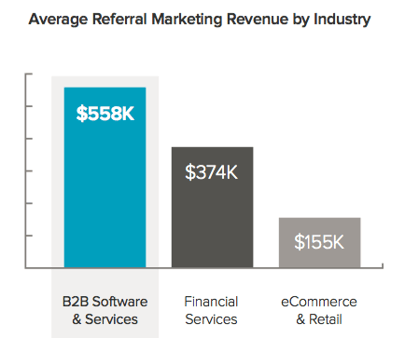Loyalty Launch Guide
How to Launch a Customer Loyalty Program in 6 Easy Steps.
Refer a client who signs an annual contract with Ambassador, and you'll earn up to 20% of the total contract value.
Enroll TodayWe explore all the elements of referral marketing incentives: the right time, the right type, and the right amount to offer to your B2B program members.
When it comes to formulating a plan for your organization's program, outlining the referral marketing incentives portion can be tricky. How much to reward? When to reward? How many activities to reward? We receive all of these questions (and more!) from a number of incredible B2B brands when we build out their referral programs.
Many people still consider referral marketing a consumer-focused strategy. There is so much evidence of amazing results from popular brands like Uber and Airbnb, but you don't hear much about the referral marketing programs that enterprise brands like HP, SAP, Volusion, and other B2B software companies have successfully scaled.
You might assume that's because B2B referral programs simply don't work. But our platform's data paints a very different picture.

As shocking as it might seem, our B2B customers average 3X MORE REVENUE than eCommerce brands over a 12-month time period! That's remarkable on its own, but it's particularly impressive when you consider that those same eCommerce customers see an average ROI that exceeds 500%.
When developing B2B program structures, this question always arises. And it's an interesting — and sometimes difficult — question to answer because most people assume that there’s only one time to pay out a B2B referral incentive: When a referred lead closes. If I refer you to a B2B software company that’s offering $500 for a referral, most programs stipulate that I’ll only see cash when you sign up and become a customer.
That’s a perfectly appropriate approach to paying out referrals, but it has one major flaw: Most B2B sales cycles are long and many businesses’ close rates are low.
What we’ve found with our B2B customers (particularly the ones with sales cycles that are longer than 30 days) is that ambassadors tend to lose interest in a referral program if their referral activity isn’t quickly rewarded. If they have to wait 30, 45, or 60 days to see some sort of financial reward for a referral, they’re less inclined to participate.
To help our customers avoid this, we’ve recommended offering a smaller incentive for referring a qualified lead (or whatever a company considers a qualified entry point into their pipeline). If that lead ultimately closes, that same referrer is then given the larger incentive for referring a new customer.
This is effective for one very big reason: When an ambassador knows that there’s a short-term incentive for simply referring a qualified lead (and a potentially bigger reward for that customer closing), it removes a critical barrier to participation and immediately ramps up referral activity.
Qualitatively and quantitatively, we’ve seen this work time and again for our customers. In fact, we analyzed referral metrics of two customers — one that follows this best practice and one that doesn’t. Here’s what we found:
![]() Customer X, which only offers an incentive for a closed sale, generated a lower number of shares over a 30-day period
Customer X, which only offers an incentive for a closed sale, generated a lower number of shares over a 30-day period
![]() Customer Y, which offers a small referral incentive for a qualified lead and a larger incentive for a closed sale, saw a 75% higher referral share rate
Customer Y, which offers a small referral incentive for a qualified lead and a larger incentive for a closed sale, saw a 75% higher referral share rate
The bottom line: Even if the incentive for referring qualified leads is low (i.e., a $25 gift card — a reasonable amount to pay for qualified B2B leads), it almost always ramps up referral activity. And, like any marketing activity, the more qualified referrals you get into your pipeline, the better your chances are of driving a healthy ROI.
I’ll get to the point: Cash is king — whether it comes in the form of actual cash (PayPal or Dwolla) or gift cards. While points, loyalty credits, and discounts might work for B2C referral programs, B2B referrers aren’t interested in those incentives. Instead, they respond to cold, hard cash.
In fact, a Nielsen Harris Poll showed that more than 77% of Americans said they preferred to be rewarded for referrals with cash.
An economically sound incentive structure is one of the most important components of an effective referral marketing strategy. That said, there's no one-size-fits-all approach to incentives. Two companies in the same industry might offer completely different incentives depending on their economic model, customer target, brand awareness, and referral goals.
As you're building out your program, it's critical to factor in your unique goals. Learn how to scale your referral marketing program in our all-encompassing guide below.
Referral program incentives are the backbone of successful campaigns. Are you ready to start rewarding?
Affiliate & referral marketing are very similar, but there are some subtle differences, do you know which is right for your business? Let us help!
For some businesses, January is a sales boon - but for most, the post-holiday spending hangover is real. Start the new year on the right foot with...
Sign up for our Ambassador newsletter and get notified when we publish new
eBooks, case studies, blog posts and more. It's like a crash course in referral
marketing - and it's free. Plus, we promise not to spam you.
Platform
© 2024 i2H Inc. All rights reserved | Privacy Policy
© 2021 Kalungi, Inc. - All Rights Reserved.
Powered by Atlas - a B2B SaaS HubSpot theme